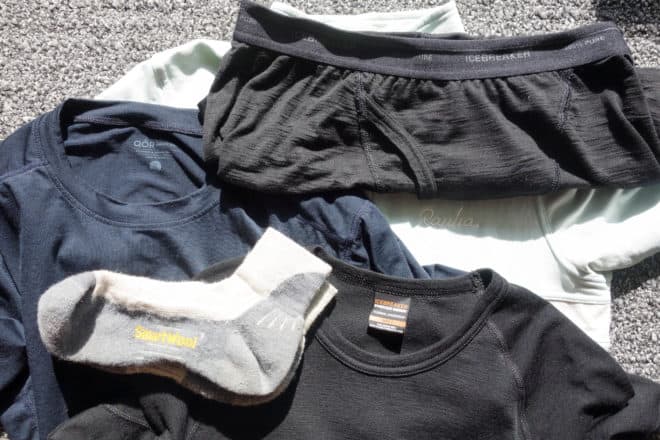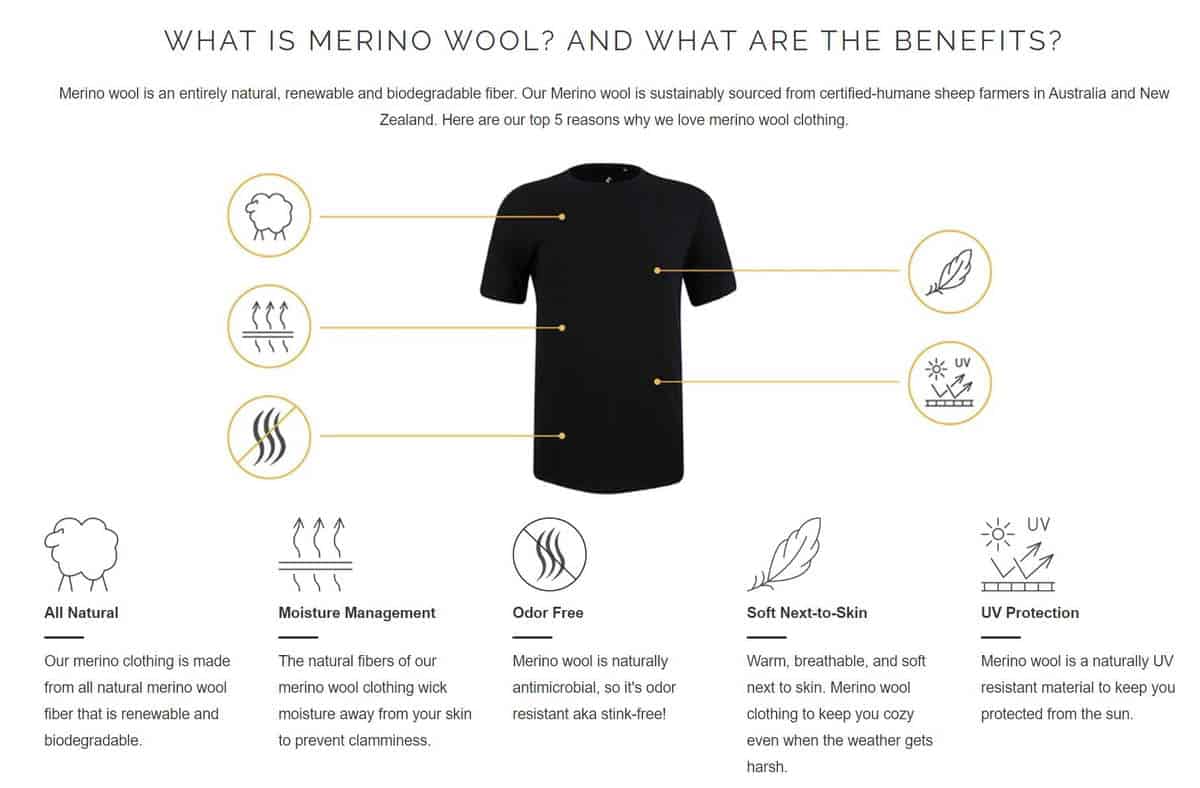Merino wool is super soft, light weight, breathable, odor resistant wool that manages moisture, is wrinkle resistant and is organic and renewable. The wool even wicks away sweat. Since I discovered this miracle fabric, produced from merino sheep, I can’t wear anything else.
Everything from every day merino under wear, merino wool socks and t-shirts in my every day life to merino base layers and merino fleeces for my photography travels. This is especially the case when weight restrictions are placed on how much gear I can bring along.
If you arrived to this post simply to find a retailer that sells merino wool let’s cover that off straight away. The two biggest brands in the merino wool retail space are Icebreaker and Smartwool, both have excellent products but they have gotten crazy expensive. There is a third less known player that I highly recommend you take a look at called Ridge Merino, Ridge Merino® was co-founded in 2014 by a husband and wife team, Jeff and Susan Russell. For a decade, Jeff had led the design and development of technical outerwear at Armada Skis so he knows a thing or two about performance gear.
Ridge Merino can not be found in retail stores which is the good news because they sell direct which means no mark up and lower overhead. Those savings get passed along to you and I. To top it off Ridge Merino also offers free shipping on orders over $49 and free returns.
 I’ve done my comparison shopping between Icebreaker, Smartwool and Ridge Merino and Ridge’s prices are drastically lower on every item. Quality is top notch and the many 5 star consumer reviews back that claim.
I’ve done my comparison shopping between Icebreaker, Smartwool and Ridge Merino and Ridge’s prices are drastically lower on every item. Quality is top notch and the many 5 star consumer reviews back that claim.
I suggest you start to recognize this new logo in the merino wool space as it has become my new go to shop for merino wool and soon to be yours.
My First Introduction To Merino Wool
In 2012, while planning my first trip to Hallo Bay, Alaska to photograph grizzly bears we were told we could not bring more than a total weight of 295 lbs including our body weight. That wasn’t going to be easy, I have my mothers hips.:))
That’s when I started to research ways to reduce my weight from clothing and I came across the Icebreaker merino wool clothing line. According to Icebreaker Sir Peter Blake, the famous yachtsman, relied on Icebreaker merino wool clothing, one piece, for over 40 days and never got smelly. Really, Really! My initial reaction to that claim was one of pure marketing hype, so I decided to put it to the test myself before my trip just to be safe.
The Merino Wool “No Stink” Challenge
Disclaimer: Some, ok 99.8% of you, will consider the events that follow positively gross, but that’s what created the buzz for us and made it worth risking a nasty untreatable skin disease.:)). WARNING DO NOT TRY THIS AT HOME.
Icebreaker clothing lays claim to being thin and made from natural fibers which makes it warm in cold weather, cool in warm weather, light, breathable, easy care, no stink and no itch. Having worn Icebreaker merino wool in Alaska for 10 days I can attest to all of the above however I was curious just how far the limits could be pushed. I enrolled three testosterone-rich Canadian guys to join me in sharing one shirt for three weeks to see if they could bring Icebreakers outdoor gear to its knees. We had two very simple rules as follows:
1/ each activity had to produce copious amounts of sweat
2/ no washes, rinses or application of good smelling products were permitted during the challenge.
Our intense sweat-filled activities over the three weeks are listed below:
- 9 8 km runs each @ 90 degrees F plus
- 3 1.5 hour hot yoga sessions @ 109 degrees F
- 36 holes of golf @ 95 degrees F
- 1 1.5 hour cycle ride at 93 degrees F
To give you some idea of what we threw at this shirt, the average male sweats out one liter per hour of activity so this shirt sucked up and spit out approximately 24 liters of man juice from four different guys over a three week period. I KNOW YUCK.
Knowing guys and gals have a very different take on what passes the smell test I made my very “hyper-sensitive to unclean” wife the judge. When handed the shirt at the end of the three weeks for the final verdict the best criticism she could come up with was to say it didn’t have that fresh out of the laundry smell. I will give her that much but what about that nasty don’t come near me smell of body odor? Definitely no body odor smell were her final words. Actually her finals words were, “It’s still gross”.
Merino Wool – Your New Best Friend
For anyone who travels or is active this little test should serve to reassure you that wherever your travels may take you or whatever activity you’re involved regardless of how long if you’re wearing Icebreaker merino wool you won’t finish up smelling like a barn yard animal in the heat of Summer.
For photographers the results of this challenge should bring a huge smile to your face as we often travel for weeks at a time to remote areas that have small plane weight restrictions and no access to laundry facilities. When it comes to photography clothing nothing else can match merino wool.
With varying 150, 200, 260, 320 weights available this makes layering for a variety of temperatures possible without having to carry more than 3-4 pieces of photography clothing for your entire trip. When merino wool clothing is layered together they lock together like a single garment with air being trapped in between each fine layer to ramp up the warmth. So a few tops and bottoms of varying weights and you’re all set for a week or a month and that makes for lighter luggage.
I wore Icebreaker merino wool base layers for a 10 day camping trip to photograph grizzly bears in Hallo Bay Alaska in September. The nights were freezing and the days were warm. I alternated between two merino wool base layers for the ten days and with all of the hiking back and forth four times a day I sweat buckets.
Of course I knew from the results of the “no stick challenge” that smell was never going to be an issue during the trip. I also knew that while I stayed cool by day I would also be warm at night. Lots of people wonder how that is.
So in this post today, all your most burning questions about merino wool will be answered, including what it is, where it comes from, and why, as a traveler, hiker, photographer, once you try on merino wool yourself you’ll never look back.
What Is Merino Wool?
Everywhere you go, it seems like people are talking about merino wool. You’ve probably seen a few merino wool products when shopping online or at your local department store. You were interested, sure, but it didn’t go any further than that, mostly because you don’t know what merino wool even is.
Well, I’m here to inform you. As I touched on in the intro, merino wool comes from a species of sheep called the Merino. Although its home is a point of contention, the sheep is said to have existed between the 12th and 13th centuries. It may come from Spain or Morocco.
In the 15th century, Spain’s economic development was bolstered by farming Merino sheep, which are beloved for their wool. By the 16th century, Spain could trade for almost anything in exchange for this rich wool.
We didn’t get what we know as merino wool today until sometime in the 18th century. It was then that in Australia and New Zealand merino wool was improved upon.
So why the Merino sheep over other sheep? Compared to other species, the Merino sheep is said to have incredibly soft and high-quality wool. The wool staples, which are fiber groups, are between 2.6 inches to 3.9 inches long.
Depending on the type of Merino sheep, someone harvesting the wool might get between 13 and 40 pounds of usable wool every year. That wool then gets produced into clothing.
What kind of clothing? Practically everything imaginable. Just take a look at Icebreaker’s website, as they’re my favorite brand of merino wool clothing. They sell all sorts of clothing made of merino wool, from tank tops to pants, leggings, hoodies, t-shirts, dresses and skirts, gloves, hats, socks, and jackets. You can even find clothing for kids made with merino wool and merino wool underwear, which is kind of crazy!
How Does Merino Wool Work?
The wool from Merino sheep contains proteins full of natural compounds and amino acids. That makes this wool especially good for a few things. These are keeping you warm, wicking away moisture, and warding off smells.
When I went to Alaska on a nature wildlife photoshoot, sure, the temperatures were cold, but I was also moving around a lot. Naturally, I would begin sweating as I was following animals and capturing incredible moments.
If you’re wearing a material like cotton, here’s what happens. The natural fibers in that cotton t-shirt absorb the moisture. In other words, the sweat sits on your skin and your shirt gets soaked too. Even though cotton is breathable and lightweight, if you start sweating heavily, you’re going to be sticky and wet sooner than later. I tried many synthetics prior to merino wool and I couldn’t get more than one wear out of them before they became ripe.
Those natural fibers in merino wool are adept at moisture absorption. When wearing a garment made of merino wool, your shirt or pants may be able to absorb up to 35x its weight. That’s a lot of sweat!
Since the sweat stays in the structure of the merino wool shirt or pants, it can’t feed microbes. These microorganisms can lead to fermentation and disease, neither of which are good. You also get stinky body odor thanks to microbes.
Studies such as this one from Small Ruminant Research have found that goat and sheep-produced fleece and wool have antimicrobials to keep microbes far away.
Further, other studies have noted that the fibers in merino wool are less appealing to bacteria like microbes compared to synthetic fibers. Why is this? Synthetics are smooth and tend to have positive ionic charges. Merino fibers though are scaly when reviewed on a microscopic level, and they carry less charge. The bacteria aren’t as likely to get through these fibers.
Even if you start really sweating then, you shouldn’t notice that your merino wool clothing gets wet, and you certainly won’t have to worry about other people smelling you. (That said, I do suggest showering when you can!)
Why Wear Merino Wool Socks?
Merino wool is the natural pick for quality, durability, warmth, softness, and style. They say you can tell a lot from a person’s socks and merino wool manufacturers have gone to great lengths to not only make merino wool socks functional but also uber stylin.
Where merino wool socks really shine though is for activities like walking, hiking and running where your feet are likely to sweat. Merino wool socks will keep you cooler or warmer and most importantly dry. That’s because merino wool socks have the ability to wick away sweat to keep you dry. You may not believe this but merino wool can retain up to 30% of its own weight in moisture and still feel dry to the touch. That compared to Nylon which wicks less than 5% and polypropylene which wicks less than 0.5%.
Merino Wool Socks And Smelly Shoes
Because merino wool socks can retain moisture so much more effectively than other fabrics that means less sweat and less sweat and therefore less smell. It’s interesting to note that human sweat on its own does not cause odor. It’s the natural bacteria on the skin and the perfect humid environment inside a shoe that incubates those bacteria. That buildup of bacteria inside your shoe is what eventually begins to smell.
Most people turn to a band-aid approach like foot powders and charcoal insoles to help with their smelly shoes but they seldom think about merino wool socks as a solution to smelly shoes. The properties we’ve discussed around moisture retention and sweat constantly being pulled away from your skin inhibits an environment that harbors bacteria.
So if you have smelly shoes turn to a pair of merino wool socks and you’ll likely find that does the trick.
How to Layer For Cold Weather?
LAYER #1: THE BASE LAYER is closest to the skin. The base layers job is to transfer moisture and provide thermal insulation. A base layer refers to underwear and the short and long sleeve shirts and pants belonging to the base layer set. With a merino wool base layer you should always feel warm and dry. Those thin fibers we discussed earlier wick moisture effectively, evaporating it into the air.
Your base layer will be a thinner knit than the mid layer, in Icebreaker terms that would be a 150 or 200. You can combine your base layer with an outer layer in cool weather and that may be sufficient. But when the temperature drops you’ll want to add a mid layer. Of course everyone experiences the cold differently so you need to experiment with your layers in various temperatures so you know what is right for you..
LAYER #2 :THE MID LAYER is worn over the base layer. The mid layer is added not only for warmth but also to breathe and to transfer moisture further outside through the covering layer. To produce warmth your mid layer needs to bind air to itself. This is where merino wool layers really shine. The more merino wool layers the more warm air settles within the knits.
A good mid layer is flexible in order to be easily worn over the base layer and not restrict your movement. This is where layers in the 260 and 330 range come into play over top of your base layer. Again depending on the temperature sometime I wear two base layers when a heavier mid layer is not warranted but I require just a little extra warmth than the one base layer can provide.
LAYER #3: THE OUTER LAYER acts like a shield to the weather, like rain and snow. And like your base and mid layer it should be breathable so it can help to get rid of any moisture. The best choice is an outer layer with no insulation that can trap moisture. My outer layer is a GORE-TEX Pro Shell.
Now that you know what the three layers are you also need to be aware that how you combine these layers requires careful consideration of variables such as weather, what kind of activity you will be doing, and knowing your body. For example, I run way colder than many of my fellow photographers so I’m always layered much heavier than they are. Getting it right is a process of trial and error and be sure to perform these tests before you leave on an important trip so you can be assured you have it right.
My last piece of advice on layering is that you get what you pay for. Merino wool is a pricey option but it is also the most versatile fabric for regulating temperature. That allows for the greatest comfort and the widest margin for error in all weather conditions. And lest we forget with merino there is the added advantage of no smell regardless of how long you wear it.
Is Merino Wool Itchy?
When you think of wool, you might envision a large, bulky, itchy sweater. Like I mentioned in the last section, nowadays, manufacturers can make any garment from merino wool, including merino wool socks and merino wool underwear, a personal favorite of mine. TMI I know:))
You wouldn’t be able to buy merino wool underwear if this fabric was really all that itchy. Some merino wool retailers produce clothing using fibers with a thickness of just 17 microns. Not sure what a micron is? Each one is the same as one-thousandth of a single millimeter.
For comparison’s sake, the hair on your own head is 60 to 180 microns. So yeah, each fiber of merino wool is thinner than even a single human hair. Your merino wool garments will feel comfortable against your skin whether worn as a base layer for travel or underwear to the office.
That said, some people with wool sensitivities have reported that even merino wool makes them itchy so if you’re that person test a sample garment to see how you react.
As a photographer, I can’t tell you how important this is. When I dress for a wildlife shoot, I want clothing that is comfortable, insulating, and moves with me. Merino wool does all that and more. Not having to worry about itchiness means I won’t ever have to choose between scratching an all-encompassing itch or taking a photo of a grizzly bear that just chased a salmon down in front of me.
How to Wash Merino Wool
Let’s say my post convinces you and you decide to invest in a few pieces of merino wool clothing for your next travels or outdoor photography shoot. I think you’ll soon agree with me that you made a great decision.
Once you get a chance to shower and change into regular clothes, you know that although your merino wool garments don’t smell that they still need to be washed. How though? Can you just toss your merino wool clothes into the washer and hope for the best? What about drying this wool?
Here are some steps to follow each time you want to clean your merino wool clothes.
Step 1: Make sure that whatever clothing you’re washing is inside out, including socks! Don’t leave socks bunched together, either.
Step 2: Turn your washer on, setting it so it cleans clothes using cold water. Hot water could cause unwanted shrinkage, so avoid even warm water to be on the safe side. Make sure you run your merino wool clothes on the gentle cycle to preserve the fibers.
Step 3: Mild soap is best for cleaning merino wool, so shop very carefully for your detergent or cleaning agent. Never use a soap or detergent with bleach, since the fibers will be seriously degraded if you do. Also, pass on the fabric softener. Merino wool is soft enough on its own; it doesn’t need further softening!
Step 4: Take your merino wool garment from the washer and put it somewhere flat so it can dry. That’s recommended and don’t tell anyone but I do hang mine to dry given I don’t have space to flat dry. If you absolutely can’t wait for your merino wool clothing to dry, then make sure you tumble-dry the clothes in your dryer on the lowest setting possible and better yet take it out before it is completely dry unless you’re intentionally trying to size it down.
Sometimes you don’t even get a choice in whether you can air-dry your merino wool clothes or use your dryer. Check the tag and if it says air-dry only, then that’s what you gotta do. Air drying is not the same as line drying, by the way. If you attach your merino wool garments to a clothesline and hang them, it can permanently wreck the shape of your shirt or pants.
That’s all there is to it! If you own any cashmere sweaters, leather clothing, or any other high-end garments, then you already take a few extra washing and drying precautions for those clothes. It’s not all that different with merino wool.
14 Reasons Why You Need to Wear Merino Wool
I know merino wool is trendy and it’s cool to buck trends, but in this case, you really should believe the hype. With autumn already here and winter not following too soon behind, the best times of the year for outdoor photography are upon us. Shivering, shaking, and sweating in the cold temps doesn’t have to accompany your photography experience anymore.
If you find that you’re still on the fence about merino wool, I think this next section will convince you. Here are 14 awesome reasons to wear merino wool all year round!
1. Natural Material
Rather than solely about fashion, for more and more people, the clothes they choose to wear are about making smart choices for their health and their bodies. Synthetic clothing includes polymers that are sourced from petrochemicals and other chemicals made from petroleum.
Does that really sound like the type of thing you want to wear on your body day in and day out? If you have allergic dermatitis or you’re prone to it, these chemicals can definitely agitate the condition. You could even develop other forms of skin irritation, including ulcers in more severe cases.
Merino wool is about as natural as it gets, after all you know it comes from the Merino sheep. Instead of the chemicals that synthetics are laced with, merino wool garments include amino acids and naturally-occurring compounds and proteins.
The sheep isn’t in any pain when its wool is removed; actually, it needs it. When a Merino sheep has an excess of wool, it can no longer manage its body temperature efficiently. This can lead to deadly overheating so it’s a win win for you and the sheep.
2. Lightweight
I know, I know, it’s going to take you some time to wrap your brain around the fact that wool of all things can be lightweight, but it can! I again stress the importance of packing light when flying around the world to do a photoshoot if you’re going to wear merino wool.
Even when I was going to frigid Alaska, I felt confident in my Icebreaker merino wool gear and packed far fewer garments than I would have before I came across this wool. And it worked! I was able to wear the same few clothes without stinking like the dickens or feeling sweaty and grungy. I was warm too.
3. Feels Great
Okay, so even I’ll admit that wearing merino wool isn’t quite the same as petting a Merino sheep if you ever get to do that. Still, given that this wool is sourced from the sheep itself, it’s still pettingly, strikingly soft and feels wonderful to wear.
4. Combats Odors
No one likes smelling like a gym sock, yet sometimes when you’re out on the scene taking photos of animals, you don’t exactly have easy access to a shower. Eventually, you’ll grow noseblind to your stench, but everyone who’s around you will not.
I wore merino wool for more than a week at a clip. I should have stunk to high heaven, but I didn’t. Granted, I’m sure I didn’t smell like roses, but there were no discernible odors on me thanks to the merino wool.
5. Keeps You Dry and Toasty
I also didn’t feel even a drop of sweat since my merino wool garments wicked it away so efficiently. Trust me, when you’re in Alaska, you do not want to wear a base layer like cotton. When it gets wet, and when you get wet in return, you’ll begin violently shaking no matter how thick your winter coat is.
With merino wool, you’re covered. The insulating qualities of this fabric are truly incredible.
6. Layerable
You can layer up entirely with merino wool and sweat won’t get trapped. What happens instead is that the wool sends sweat from your body layer by layer while the sweat is still in a vaporous state.
I would even recommend that if you do want to layer up that you don’t add other fabrics in between the merino. Otherwise, your sweat will get stuck on that layer, not able to get to the next layer of merino wool. You’ll start sweating and stinking up the place pretty soon.
7. Not Itchy
I know I devoted a whole section of this post to it, but I want to reiterate that indeed, merino wool isn’t itchy. Again, the only exception is if you have very sensitive skin. Even then, you may find merino wool more comfortable than other fabrics because it’s designed to feel great.
8. Durable
I’ve talked about cotton several times throughout this post. Not only does merino wool wick away moisture and insulate like cotton never could, but the wool is a lot stronger too. You get 6x the strength compared to a cotton garment with merino wool.
If you were to take the cotton fibers in an average t-shirt and fold them over atop themselves, it takes approximately 3,200 instances before the fibers will break. Merino wool fibers will break after 20,000 times. Talk about an impressive lifespan!
9. Won’t Wrinkle
If you’re going to be wearing the same clothing day in and day out for a while, you don’t want it to look it. Merino wool fibers are quite elastic so you can skip the iron and the ironing board (which you probably don’t have access to anyway) and wear your merino clothes for days at a time without folds and wrinkles.
Yes, that’s even if you pack the merino clothes in your suitcase or luggage. Photographers who travel a lot, pay attention!
10. Hypoallergenic
Do you have allergies to certain fabrics and materials? Then you know you have to be ultra-choosy about what you put on your body. Fortunately, merino wool shouldn’t trigger any allergic reactions.
Like I said before, unlike synthetics, merino wool isn’t made with skin-irritating petrochemicals. If you have eczema or your baby does, studies have shown that sweaters and t-shirts made of merino wool are especially great at preventing the onset of symptoms.
11. Resistant to Fire
Merino wool doesn’t melt in hot temperatures, nor should it ignite. You won’t get that same kind of protection with polyester. Once temperatures hit highs of 452 degrees Fahrenheit, polyester begins to melt. For nylon, it’s even less heat, as it will melt at 320 degrees or so.
So go ahead, sit at that firepit or campfire without worrying about your clothes catching on fire, because they certainly won’t.
12. Protects from Damaging Sun Rays
UV radiation is a serious threat in our day-to-day lives. Sure, at the least, you could end up with a nasty sunburn, but at worst? So many bad things can happen. All those free radicals from excessive sunlight can prematurely age you and put you at risk of cancer, cataracts, inflammatory diseases, and cardiovascular disease as well.
Even if it’s not particularly sunny, and even now that summer is over, you still need to safeguard your skin. Fortunately, merino wool has a UPF 20+ protection factor.
What is UPF? Short for Ultraviolet Protection Factor, UPF is only about how well your clothing protects you from sun damage. Compare that to Sun Protection Factor or SPF, which is a measure of sunblock effectiveness.
A clothing product with a higher UPF will ward off UVA and UVB rays. If you can find merino wool with a UPF of 50, then you can be confident that your clothing will protect you from almost all UV rays (98 percent).
13. It Biodegrades, Helping the Planet
As a nature and wildlife photographer, you greatly appreciate our planet and the beautiful animals that inhabit it. You of course make smart daily choices to preserve that planet, since we only have one earth.
Buying merino wool is a great choice for the planet. Once you dispose of your merino wool clothes for good, in about a year, the wool will biodegrade. The ground happily absorbs the amino acids and proteins, sending nutrients and carbon to the soil that can encourage new growth. How nice is that!
14. It’s Also Renewable
Remember, a single Merino sheep can produce 40 pounds of wool in a year. Then, the next year, they start the growing process all over again. For the life of the sheep then, the wool produced from it is considered a renewable resource.
You’re also potentially saving a Merino sheep’s life when you buy their wool, as having the wool removed prevents the sheep from overheating and possibly dying from it.
Is Merino Wool Better Than Regular Wool?
Merino wool outperforms regular wool which can be from sheep, rabbits, goats and even camels in every way.
Merino wool regulates temperature better than regular wool to keep you cool in Summer and warm in winter. That’s why merino wool is regarded as being one of the best materials for base layers because it performs exceptionally well in different weather conditions.
Take a look at the image and you’ll quickly see why merino feels great against your skin, which is why merino wool is the #1 choice for base layers. Due to its fine fibers, merino is incredibly soft, less itchy and also quite lightweight, making it a very comfortable material to wear. And did I mention it doesn’t stink, unlike synthetics.
The fibers are also quite flexible, which adds to its durability and it helps the garment made out of merino wool adapt better to movement and last longer.
Merino wool is also more water resistant than regular wool and dries much faster. This especially the case with the lighter 120,150 layers. Regular wool, due to the thickness of the fibers absorbs more moisture and therefore take a lot longer to dry.
The choice is clear, if you’re active, travel and embrace all the seasons this planet has to offer merino wool is the only choice to be as comfortable and odor free as humanly or should I say as “sheepily” as possible.
Conclusion
Merino wool has become my go to fabric since my first trip to Alaska in 2012. For eight days, I was able to photograph the wildlife in Alaska without worrying about being itchy, sweaty, cold, or uncomfortable because I wore merino wool layers.
The colder months are already arriving here in Canada so I will be breaking out my mid layers soon enough. If you have any outdoor travels or photo shoots planned or are simply active including hiking and biking then I would highly, highly recommend you consider buying merino wool garments. This is especially the case for travelers hopping on a plane that has weight restrictions. Of course, merino wool isn’t just for travel, be honest you still have that image of me in my merino underwear at the office.:))
Seriously, as a photographer, the last thing I want to think about when shooting is what I’m wearing, whether I’ll be warm enough and whether my companions think I stink and merino wool makes that possible.
Happy Shopping.



















Comments
David Yarrow Wildlife Photography MasterClass | Cool Wildlife
Comments are closed.